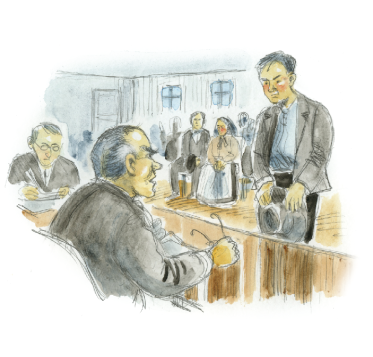Hitta hit
GPS
WGS84: N 56° 46.9961', E 12° 49.949'
Decimal: 56.7833, 12.8325
TINGSHUSET
Kvibille tjänade under många århundraden som häradets tingsstad. Det var alltså här, som rättsliga tvister rörande befolkningen i Halmstads härad löstes. I tingssalen har folk både dömts till döden och friats.
Redan på dansktiden har det med största sannolikhet funnits rättskipning här. 1683 introducerades här svensk lag genom att lagmän från Sverige samlade befolkningen och talade om att nu gäller svensk, och inte dansk, lag.
När det äldsta tingshuset byggdes i Kvibille har inte kunnat fastslås.Det fanns emellertid i början av 1700-talet och var redan då illa medfaret. Underhållet av fastigheten har varit i ständigt blåsväder genom åren. Tingsrätten gick 1714 till landshövdingeämbetet med ”begäran om 91 riksdaler till denna nödvändiga reparation”, men inget hände.
Det var inte förrän hösten 1731 som man kom överens om att bygga ett nytt tingshus i exakt samma storlek, då det gamla var bortom räddning. 1734 stod det klart, och innehöll förutom tingssalen häradshövdingens kammare och skrivarekammaren, bostad för häradshövdingen samt förstuga.
Rumsindelningen är i stort densamma i dag.
Även den olycksalige dråparen Jacob Olsson Qwick fick här i Tingshuset höra sin dödsdom. Qwick förvarades under rättegångsdagarna i en fångcell i Tingshusets källare.
På tingshusets ovanvåning finns i dag ett skolmuseum. Kontakta Kvibille Hembygds-förening för besök.
Under 1880-talet togs frågan om en omorganisation upp, och en del ville att tingsrätten för Halmstads härad skulle förläggas till Halmstad. Efter mycket diskussioner beslöts att det nya tingshuset skulle placeras i Halmstad, på av staden erbjuden mark vid Bredgatan.
Hösttinget 1889 satte punkt för Kvibilles månghundraåriga tradition som häradets tingsstad. Sista rättegången blev arbetstyngd, 27 mål avverkades under en tio timmar lång session. Dagen avslutades med en fest i den gamla byggnadens lokaler, häradshövdingen och domaren Theorin hyllades för visad domareskicklighet och den gamle häradstjänaren tackades för ovanligt lång tjänst.
Det gamla tingshuset fick en ny ägare genom att A.R Holm inköpte det till okänt pris. Holms flyttade senare in i huset, och efter makens död 1899 bodde fru Holm kvar.
Hon avled 1920 och hade testamenterat tingshuset till Kvibille socken att användas till ålderdomshem. Och så användes det fram till slutet av 1950-talet, då det gamla tingshuset blev kommunalkontor. I samband med Halmstads och Kvibilles sammanslagning 1974 lades kommunalkontoret i Kvibille ned och huset har sedan dess använts till fritidsverksamhet.
THE COURT HOUSE
Kvibille served as the District Court for many centruries. Thus, it was here legal disputes concerning the people of Halmstad were resolved. Even in the Danish times, they held trials here. In 1683, Swedish law was introduced by lawmakers from Sweden who gathered the population and declared that from here on, Swedish law was the only law. When the oldest tingshus was built in Kvibille is not possible to determine. However, it existed in the early 18th century and was even at that time in bad condition. The maintenance of the property has been in constant dispute throughout the years. It was not until autumn 1731 that people agreed to build a new townhouse exactly the same size, since the old one was beyond saving. In 1734 it was complete, and contained, beside the courtroom the residence of the chief executive officer. The division of space is largely the same today.
Even the unfortunate slayer Jacob Olsson Qwick got to hear his death sentence here in The Courthouse. During the trial days he was stored in a prison cell in the basement.
The top floor currently contains a School Museum. Contact Kvibille Hometown Association for visits.
During the 1880s, the issue of reorganization was raised, and some wanted the court to be moved to Halmstad. After much discussion, it was decided that the new Courthouse would be located in Halmstad, on the land the city offered at Bredgatan.
The Autumn Court session in 1889 marked the end for Kvibille's centuries-old tradition as the Court town of the region. The last day of trials was intense, 27 trials were completed during a ten-hour session. The day ended with a celebration in the rooms of the old building. The judge Theorin was acclaimed for demonstrated skills as judge and the old servant was ceremoniously thanked for unusually long service.
The old Courthouse got a new owner when A.R Holm bought it for an unknown price. The Holms moved into the house later and after her husband's death in 1899, Mrs Holm remained.
When she passed away in 1920, she had willed the house to Kvibille parish to use as a retirement home. And as such it was used until the late 1950s, when the old Town Hall became a Municipal Office. In conjunction with Halmstad and Kvibilles mergers in 1974, the Municipal Office was closed down in Kvibille, and the house has since been used for leisure activities.
KULTURARVET I KVIBILLE


